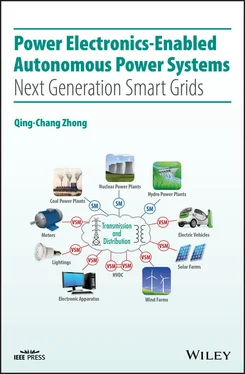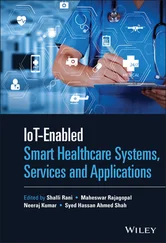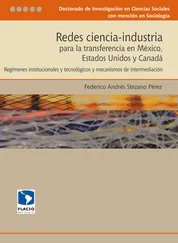The large‐scale utilization of DERs, including renewables, EVs and energy storage systems, brings unprecedented challenges to grid stability, reliability, security, and resiliency (Zhong and Hornik 2013). The conventional centralized control paradigm is no longer feasible for power systems with millions of relatively small and distributed generators.
Adding an ICT system into power systems, hence the birth of smart grids, has emerged as a potential solution to make power systems friendlier to the environment as well as more efficient (Amin 2008; Amin and Wollenberg 2005). The main characteristics of smart grids in comparison to today's grids are shown in the second and the third columns of Table 1.1, with a prominent intention to address all problems via adding an ICT system. More details about smart grids can be found from the literature, e.g. (Amin and Wollenberg 2005; DOE 2009; Ekanayake et al. 2012; Fang et al. 2012; Farhangi 2010; Momoh 2012).
Table 1.1Comparison of today's grids, smart grids, and next‐generation smart grids.
| Characteristic |
Today's grid |
Smart grid |
Next‐generation smart grid |
| Role of ICT |
Constantly growing |
Tendency to introduce bidirectional ICT into every part and corner of power systems |
Unidirectional ICT for monitoring and management but not for control to prevent cyber‐attacks and single point of failures |
| Load participation in system regulation |
Limited, non‐participative (passive) |
Binary (ON/OFF) demand responses enabled by ICT |
Autonomous, continuous demand responses for fully active regulation of frequency and voltage, without the need of ICT |
| Generation mix and DER integration |
Dominated by central generation with limited but growing current‐controlled DER units |
Diversifying, with mostly current‐controlled DERs, strong tendency of relying on ICT |
DER dominated or even 100% renewable with grid‐friendly, compatible DERs, autonomous system regulation without the need of ICT |
| Cascading failures and blackouts |
Inherent, systemic flaw |
Significantly reduced number of incidents enabled by ICT but catastrophic when it happens |
Built‐in capability of preventing local faults from cascading into wide‐area blackouts |
| Resiliency against faults and natural disaster |
Vulnerable to faults, natural disasters, and the resulting cascading failures |
Significant improvement enabled by ICT |
Fully autonomous, mutually supported, fast recovery, reduced burden on utilities, without the need of ICT |
| Cyber‐security |
Vulnerable to malicious cyber‐attacks |
Significantly improved but still a systemic flaw |
No access to the system through ICT; no more cyber‐attacks to power systems |
| Power quality |
Focus on outages, sometimes low power quality |
A priority with a variety of quality/price options |
Built‐in control flexibility and functions to fundamentally reduce faults and outages and improve voltage quality |
| System‐wide efficiency |
Limited means for improvement |
Significant improvement enabled by ICT but causing data explosion and ever‐increasing complexity |
Organic and harmonious operation underpinned by optimally designed components and system architecture |
1.3.3 Next‐Generation Smart Grids
As mentioned before, adding an ICT system into power systems does not solve the problem of how active players, such as DER units and flexible loads, interact with the grid at the physical level. This could also lead to serious concerns about reliability if their operation has to rely on the ICT infrastructure (Eder‐Neuhauser et al. 2016; Overman et al. 2011). If the ICT system breaks down then the whole power system could crash. Moreover, when the number of active players reaches a certain level, how to manage the ICT system is itself a challenge. What is even worse is that adding ICT systems to power systems opens the door for cyber‐attacks by anybody, at any time, from anywhere, making it a systemic flaw. While ICT systems could certainly bring many benefits to the operation and management of power systems, there is a need to confine the role of ICT.
It is envisioned that the next‐generation smart grids will be power‐electronics‐enabled autonomous power systems without relying on ICT systems, underpinned by the synchronization mechanism of synchronous machines that brings backward compatibility to current power systems (Zhong 2013b, 2016b, 2017e,f).
Table 1.1outlines the main characteristics of the next‐generation smart grids with comparison to today's grids and smart grids. The prominent features of the next‐generation smart grids include:
That the role of ICT is defined to be unidirectional for monitoring and management only, excluding control, to prevent cyber‐attacks and single point of failures.
That all active players are unified with the same rule of law, which is backward compatible with today's grid, to achieve autonomous operation without relying on ICT and prevent wide‐area blackouts.
That it is governed by a harmonious system architecture that allows the grid to expand as well as to decompose when needed, e.g., in the case of faults to prevent local faults from cascading into wide‐area blackouts.
In this chapter, the motivation and purpose of this book are briefly presented before describing the structure and contents of the book. Then, the evolution of power systems is outlined, highlighting the prominent features of next‐generation smart grids with comparison to today's grids and the current‐generation smart grids. The next‐generation smart grid has three prominent features: (1) the role of ICT is defined to be unidirectional for monitoring and management only, excluding control, in order to prevent cyber‐attacks and single point of failures; (2) all active players are unified with the same rule of law, which is backward compatible with today's grid, in order to achieve autonomous operation without relying on ICT and to prevent wide‐area blackouts; and (3) it is governed by a harmonious system architecture that allows the grid to expand as well as to decompose when needed, e.g., in the case of faults to prevent local faults from cascading into wide‐area blackouts.
Parts I– Vwill present the theoretical framework for next‐generation smart grids, its underpinning technical routes, and case studies in detail.
Part I Theoretical Framework
Chapter 2 Synchronized and Democratized (SYNDEM) Smart Grid
In this chapter, a theoretical framework referred to as the SYNDEM smart grid is presented for the next‐generation smart grids – power electronics‐enabled autonomous power systems. This covers the concept of SYNDEM smart grids, the rule of law that governs SYNDEM smart grids, the legal equality for all SYNDEM active players to take part in grid regulation, the SYNDEM grid architecture and its potential benefits, a brief description of technical routes, its primary frequency response, and the roots of the SYNDEM concept.
The paradigm shift of power systems has been recognized by many visionary thinkers. President Pöttering of the European Parliament says that “this is no Utopia, no futuristic vision: in twenty‐five years' time, we will be able to construct each building as its own ‘mini power station producing clean and renewable energy for its own needs, with the surplus being made available for other purposes.” Jeremy Rifkin calls it the transition from hierarchical to lateral power in his book The Third Industrial Revolution (Rifkin 2011) and stresses that the lateral power will have the same kind of transformative effect on society as steam power and the printing press first had, followed by electric power and television. John Farrell calls it the democratization of the electric system (Farrell 2011).
Читать дальше












